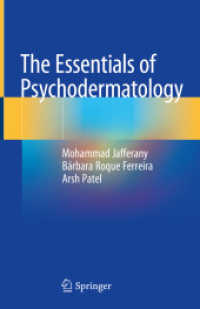Full Description
www.oup.com/blackstones/criminal/ Coronavirus Updates & Special Supplement Led by Professor David Ormerod and David Perry QC, Blackstone's Criminal Practice brings together an expert team of authors with a commitment to deliver a work which offers the right coverage for criminal practice and authoritative statements of the law in a practical and accessible format. With an accompanying supplement containing essential primary materials and commentary updates throughout the year, and access to regular web updates and the additional analysis provided byBlackstone's Briefing, you can rely on Blackstone's Criminal Practice to be your constant companion.The 2021 edition has been meticulously revised to provide extensive coverage of all new legislation, case law, Sentencing Guidelines, and Criminal Procedure Rules 2020 and Practice Directions. Throughout the COVID-19 pandemic, Blackstone's Criminal Practice 2021 continues to provide readers with regular digital-only Special Supplements to cover temporary changes to the law and procedure implemented to address the criminal justice response to COVID-19.
Contents
PART AA1: Actus reusA2: Mens Rea: the external elements of an offenceA3: General defencesA4: Parties to offencesA5: Inchoate offencesA6: Corporate LiabilityA7: Human rightsA8: Territorial and extra-territorial jurisdictionA9: European Union LawPART B: OFFENCESB1: Homicide and related offencesB2: Non-fatal offences against the personB3: Sexual offencesB4: Theft, handling stolen goods and related offencesB5: Fraud and blackmailB6: Falsification, forgery and counterfeitingB7: Company, commercial and insolvency offencesB8: Damage to propertyB9: Offences affecting securityB10: Terrorism, piracy and hijackingB11: Offences affecting public orderB12: Offences relating to weaponsB13: Offences affecting enjoyment of premisesB14: Offences against the administration of justiceB15: CorruptionB16: Revenue customs and social security offencesB17: Offences involving misuse of computersB18: Offences involving writing, speech or publicationB19: Offences related to drugsB20: Offences relating to dangerous dogs and animal welfareB21: Offences relating to money laundering and the proceeds of criminal conductB22: Immigration offencesPART C: ROAD TRAFFIC OFFENCESC1: Definitions and basic principles in road traffic casesC2: Procedure and evidence in road traffic casesC3: Offences relating to driving triable on indictmentC4: Offences relating to documents triable on indictmentC5: Drink-driving offencesC6: Summary traffic offencesC7: SentencingC8: Schedules 2 and 3 to the Road Traffic Offenders Act 1988PART D: PROCEDURED1: Powers of investigationD2: The decision to prosecute and diversionD3: Courts, parties and abuse of processD4: Criminal Procedure Rules and case managementD5: Preliminary procedures in magistrates' courtsD6: Classification of offences and determining mode of trialD7: BailD8: Assets recoveryD9: DisclosureD10: Sending cases from the magistrates' court to the Crown CourtD11: The indictmentD12: Arraignment and pleasD13: JuriesD14: Special measures and anonymity ordersD15: Trial on indictment: general matters and pre-trial procedureD16: Trial on indictment: the prosecution caseD17: Trial on indictment: the defence caseD18: Trial on indictment: procedure between close of defence evidence and retirement of juryD19: Trial on indictment: procedure relating to retirement of jury and verdictD20: Trial on indictment: sentencing procedureD21: Summary trial: general and preliminary mattersD22: Summary trial: the course of the trialD23: Sentencing in the magistrates' courtD24: Trial of juvenilesD25: Behaviour orders: ASBOs, Closure Orders, SCPOs, and VOOsD26: Appeal to the Court of Appeal (Criminal Division) following trial on indictmentD27: Procedure on appeal to the Court of Appeal (Criminal Division)D28: Reference to the Court of Appeal (Criminal Division) following trial on indictmentD29: Challenging decisions of magistrates' courts and of the Crown Court in its appellate capacityD30: Appeals to the Supreme Court and the role of the European Court of Justice and the European Court of Human RightsD31: ExtraditionD32: Public fundingD33: CostsPART E: SENTENCINGE1: Sentencing: general provisionsE2: Custodial sentences: general provisionsE3: Mandatory life sentencesE4: Dangerous offendersE5: Prescribed custodial sentencesE6: Suspended sentencesE7: Custodial sentences: detention and custody of offenders under 21E8: Community ordersE9: Youth rehabilitation ordersE10: Referral ordersE11: Reparation ordersE12: Absolute and conditional dischargesE13: Binding overE14: Orders against parentsE15: FinesE16: Compensation ordersE17: Restitution ordersE18: Deprivation and forfeiture ordersE19: Confiscation ordersE20: Recommendation for deportationE21: Exclusions and disqualificationsE22: Mentally disordered offendersE23: Notification requirements under the Sexual Offences Act 2003E24: Rehabilitation of offendersPART F: EVIDENCEF1: General principles of evidence in criminal casesF2: The discretion to exclude evidence; evidence unlawfully, improperly or unfairly obtainedF3: Burden and standard of proof and presumptionsF4: Competence and compellability of witnesses and oaths and affirmationsF5: Corroboration and Care WarningsF6: Examination-in-chiefF7: Cross-examination and re-examinationF8: Documentary evidence and real evidenceF9: Public policy and privilegeF10: Opinion evidenceF11: Admissibility of previous verdictsF12: Character evidence: evidence of bad character of accusedF13: Character evidence: admissibility of evidence of accused's good characterF14: Character evidence: evidence of bad character of persons other than the accusedF15: The rule against hearsay: general principlesF16: Exceptions to the rule against hearsay (excluding confessions)F17: The rule against hearsay: confessionsF18: Evidence of identificationF19: Inferences from silence and the non-production of evidenceAPPENDICESAppendix 1: Codes of Practice under the Police and Criminal Evidence Act 1984Appendix 2: Attorney-General's GuidelinesAppendix 3: The Code for Crown ProsecutorsAppendix 4: Disclosure








